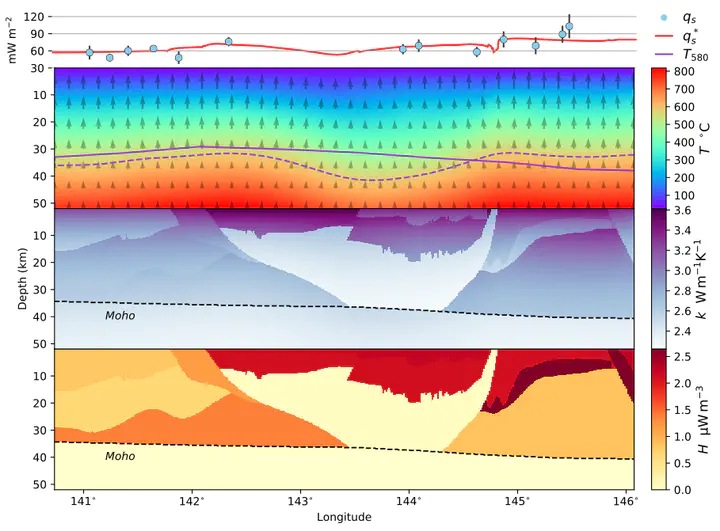 Model with the optimal tradeoff between Curie depth, heat flow data and a priori estimates of thermal conductivity and rates of heat production.
Model with the optimal tradeoff between Curie depth, heat flow data and a priori estimates of thermal conductivity and rates of heat production.Abstract
The variation of temperature in the crust is difficult to quantify due to the sparsity of surface heat flow observations and lack of measurements on the thermal properties of rocks at depth. We examine the degree to which the thermal structure of the crust can be constrained from Curie depth and surface heat flow data in Southeastern Australia. We cast the inverse problem of heat conduction within a Bayesian framework and derive its adjoint so we can efficiently find the optimal model that best reproduces the data and prior information on the thermal properties of the crust. Efficiency gains obtained from the adjoint method facilitates a detailed exploration of thermal structure in SE Australia, where we predict high temperatures within Precambrian rocks of 650°C due to relatively high rates of heat production (0.9–1.4μW/m³). In contrast, temperatures within dominantly Phanerozoic crust reach only 520°C at the Moho due to the low rates of heat production in Cambrian mafic volcanics. A combination of Curie depth and heat flow data are required to constrain the uncertainty of lower crustal temperatures to ± 73°C. We also show that parts of the crust are unconstrained if either dataset is omitted from the inversion.
Modelling temperature in the Earth’s crust is accomplished by populating a geological model with thermal properties, such as thermal conductivity and rates of heat production, and solving a numerical model of thermal diffusion with assigned boundary conditions. The desired temperature solution is often the one that best matches our observations – e.g. temperature in a well – but strong assumptions are made of how thermal properties vary with depth, which result in simple first-order predictions of the temperature field.
Posing an inverse problem is a way to ascertain how much your observations tells you about a particular model. Finding better and better solutions usually require running model after model with slight changes in the input parameters to find a better fit to the observations. For instance, a lower rate of heat production in one layer of the Earth’s crust may result in a better match to an observation of heat flow coming out of the ground. This is fine if the number of unknowns is small, but when we start to increase the quantity of unknown parameters then it takes an exponentially long time to find the model that best reproduces our observations.
In this paper, we formulate a novel inversion method that uses the gradient to quickly find the optimal configuration of thermal properties that best match our observations. We publish improved estimates of the thermal state of the crust in Victoria using heat flow measurements and Curie depth in a joint inversion using 3D geological models, and numerical models of thermal diffusion. The outcome of this work is an estimation of basal heat flux, thermal properties, and the rate of heat production for various domains in the model together with uncertainty information.